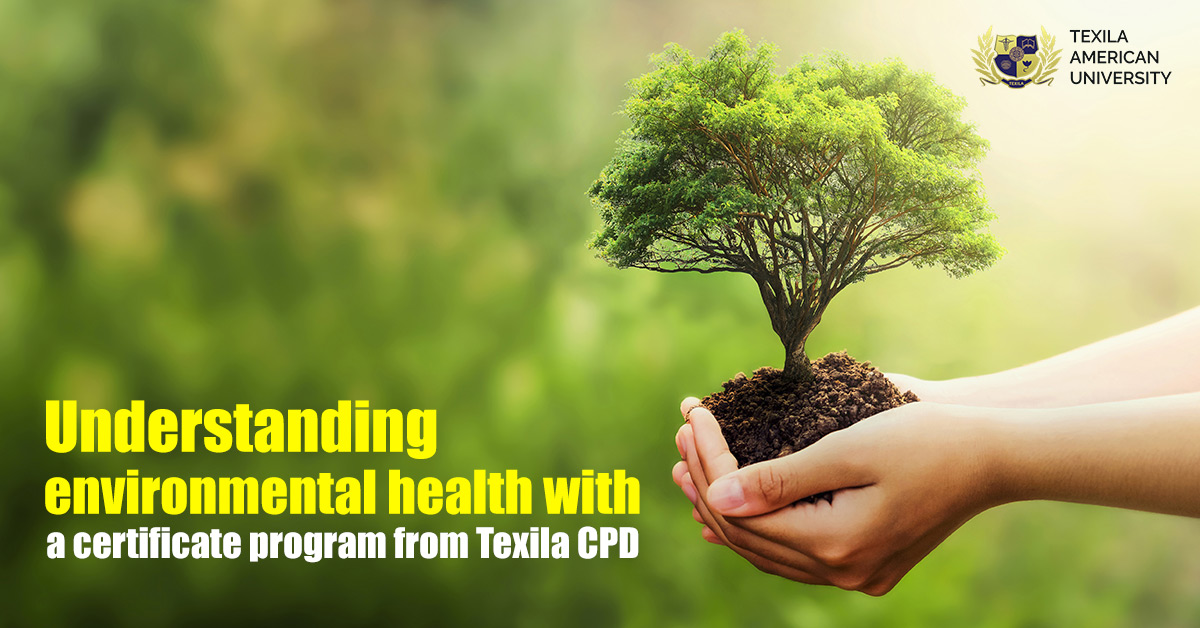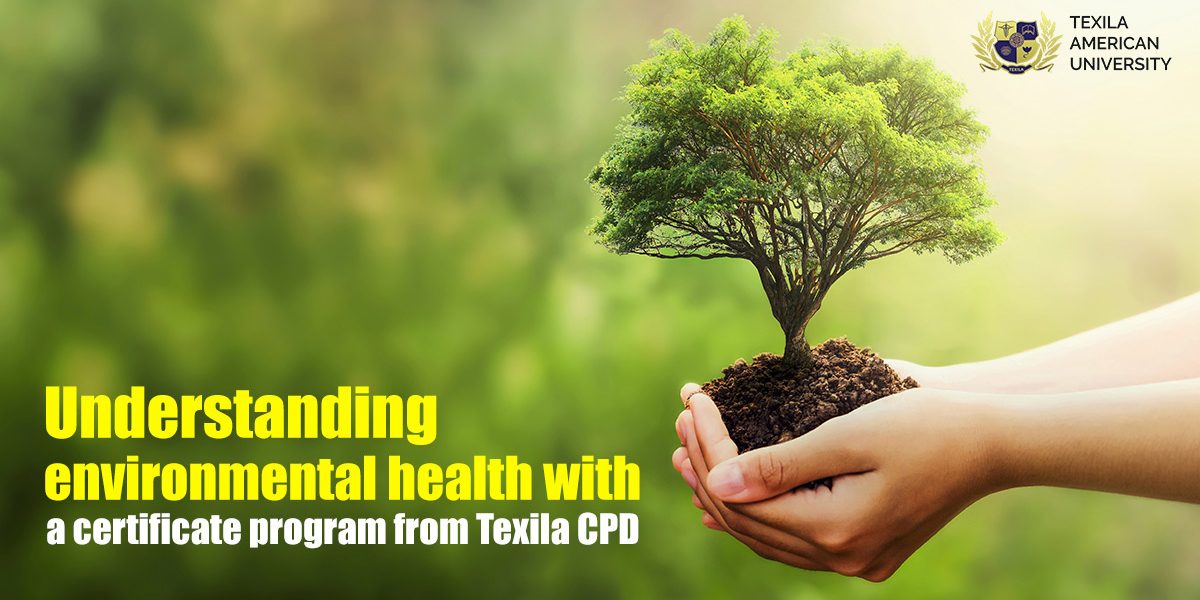Blog Summary:
Environmental health deals with the relationship between human beings and the environment. The lives of humans are interlinked with the environment as the varied conditions of the environment we live in have an effect on our physical and mental health. WHO states that around 24% of global deaths are due to environmental factors, and maintaining healthy environments could prevent almost a quarter of diseases. Water and sanitation, chemicals and radiation, air pollution, built environments and climate change are key areas of environmental health. Adapting best practices in maintaining healthy environments boosts living standards, reduces disease outbreaks, enhances biodiversity and habitat protection and limits global warming. Water-borne and respiratory diseases, natural disasters, and lack of nutrition are some of the problems caused due to environmental conditions. A certificate in environmental health helps you understand the global environment creating awareness of the ways and means to control and prevent health threats.
Environmental health deals with the relationship between human beings and the environment. The lives of humans are interlinked with the environment as the varied conditions of the environment we live in have an effect on our physical and mental health. Environmental health covers various elements like pollution, toxic chemicals, climate, food, safe drinking water, infrastructure, etc., that affect our body and emotional well-being.
A certificate in environmental health helps you understand the global environment. Also, the dynamics of how various ecological conditions cause human health hazards. It also creates awareness of the ways and means to control and prevent health threats. It enables you to understand how healthy environments enhance living standards.
WHO states that around 24% of global deaths are due to environmental factors and maintaining healthy environments could prevent almost a quarter of diseases.
Requirements for healthy living standards include:
- Fresh air
- Clean water and sanitation
- Hygiene and proper shelter
- Stable climate
- Safe use of chemicals
- Protection from radiation
- Healthy and safe workplaces
- Safe agricultural practices
- Cities and environments supporting good health
Adapting best practices in maintaining the health and safety of our environment ensures excellent physical and mental well-being for humans.
Several environmental health conditions affect human health. Let’s look at the five critical areas of environmental health that can affect us as they are essential to sustaining life and building a healthy environment:
1) Water and sanitation:
Approximately 800 million people living without access to clean and safe drinking water is a critical health concern. It leads to people taking extreme measures to secure water bodies that can negatively impact the environment.
2) Chemicals and radiation:
Toxic gases, pollutants, and radiation severely impact the well-being of humans and the environment. Cancer and asthma attacks are common among individuals and farmers who deal with pesticides. Analysis suggests that this increases the incidence of brain cancer by 20% in individuals with exposure to agricultural pesticides.
3) Air pollution:
Power plants, factories, burning of fossil fuels, industrial wastes, volcano eruptions, and wildfires pollute the air. Toxic gases harm plants and animals and severely affect the human respiratory system. Declining air quality and climate change directly influence each other.
4) Built environments:
Shelters provide safety and security to people, but too many buildings can harm the environment. Poor construction design produces too much waste and consumes lots of water and energy.
5) Climate change:
Climate change is a serious threat as it disrupts life and causes natural disasters. WMO states that, disasters related to weather, climate, or water have caused 115 million deaths and US$ 202 million in losses over the past 50 years. The number of disasters due to climate change and extreme weather has increased by a factor of five.
Importance of environmental health:
Protecting, monitoring, and ensuring environmental health is critical as it significantly impacts physical and emotional states.
1) Reduce disease outbreaks:
Over the past three years, we have witnessed the harmful effects of the covid-19 pandemic. Unhealthy environmental conditions increase the building of disease-causing agents and expose people to harmful microbes and pathogens, highly impacting those affected by disease and injury. The most common are non-communicable diseases like ischaemic heart disease, chronic respiratory diseases, respiratory infections, stroke, and cancers. Healthy and clean environments can help reduce disease outbreaks.
2) Boosts living standards:
The quality and longevity of an individual’s life increase with access to nutritious food, clean and safe drinking water, and proper shelter. A study conducted in 24 African countries examined the impact of the quality of the environment on longevity. It states that an increase in environmental performance index (EPI) and ecosystem vitality (EV) increased the life expectancy by 0.137 and 0.1417 years, respectively, in Africans.
3) Enhances biodiversity and habitat protection:
Biodiversity is essential for ecosystems and animals to flourish; its loss significantly affects the health of communities. Well-functioning ecosystems provide access to clean air, fresh water, medicines, food security, and fuel sources, thereby improving the health of global communities. Changes in the ecosystem affect subsistence, income, local migration, etc.
The biological diversity of microorganisms, plants, and animals:
- Provide adequate nutrition by sustaining soil productivity and providing the genetic resources for crops, livestock, and marine species harvested for food.
- Help make significant medical and pharmacological discoveries that help treat several health issues and diseases.
- With 60% of the world population utilizing traditional medicine, communities depend on the natural products collected from the ecosystem.
Creating awareness of environmental health helps in providing better protection for the resources.
4) Limits global warming:
Human activities like transportation, industries, electricity production, etc., raise greenhouse gas emissions, deteriorating the quality of the atmosphere. These gases trap heat and gradually increase the earth’s temperature. Specific measures and solutions are needed to bring down global temperature levels. Reducing industrial emissions can significantly help reduce their impact on global warming, thereby improving environmental health.
Issues that impact health due to environmental conditions:
Water-borne diseases:
Cholera, diarrhea, dysentery, typhoid, etc., are diseases transmitted due to contaminated drinking water and poor sanitation facilities. People from low-income households are at severe risk of contracting water-borne diseases. WHO states that nearly 2 billion people live without access to clean and safe drinking water, causing 485,000 deaths.
Respiratory diseases:
Air-borne toxins get into our lungs, causing severe respiratory diseases. Ensuring clear and pollutant-free air prevents the spread of these diseases.
Natural disasters:
Natural disasters occur even in healthy environmental conditions. Its impact can be minimized by taking necessary measures and precautions.
Lack of nutrition:
Without access to nutrient-rich foods, our bodies cannot function efficiently. Improving biodiversity provides nutrition-rich foods.
Significance of pursuing a certificate program:
TAU offers the best certificate course in environmental health online, which is of three-month duration. It:
- Introduces you to the concepts of health, environment, disease, behavior, and risks
- Identify, assess and address environmental health threats
- Identify, evaluate and address occupational and domestic health threats.
The curriculum of the certificate in environmental health online program includes:
- Foundation of environmental health
- Safety of the domestic environment
- Environmental hazards
- Occupational and environmental health threats and safety measures
Career Prospects:
A certificate in environmental health opens you to various job roles in organizations dealing with conserving ecological health, like health departments, private businesses, hospitals, enforcement agencies, etc.
Ways to enhance environmental wellness:
With rising awareness, several industries and businesses are taking necessary measures to reduce emissions by:
- Utilizing solar and wind energy instead of fossil fuels
- Eliminate air pollution by destroying the pollutants at the source with Regenerative thermal oxidizer (RTO) technology
- Car manufacturers are recycling aluminum and batteries from scrapped vehicles, by improving the recycling process.
We can do our bit to maintain a healthy environment by:
- Reducing carbon footprint by taking a walk or riding the bike
- Reuse and recycle products to minimize waste
- Utilize appliances that help save energy
- Share reading materials or read online. Save on paper by printing less
- Eat fruits or vegetables that are produced in your locality
- Save water, turn off the tap when not required
- Use reusable coffee cups and food containers
- Ensure that the products you use every day are non-toxic
- Use reusable bags during purchases
- Unplug and turn off appliances and electronics when not in use to reduce heat
- Educate yourself and create awareness
Key Takeaways:
Maintain a healthy relationship with the environment by adopting a sustainable lifestyle, protecting natural resources, and eliminating emissions. Also, ensure that your personal surrounding is clean and organized. Acquire knowledge and contribute to the welfare and safety of the global environment. Even small behavioral changes can make a positive impact. Environmental wellness improves personal health as well as the health of global communities. Enroll in the best certificate course in ecological health offered by Texila and enhance your understanding and knowledge of sustainable wellness practices.


